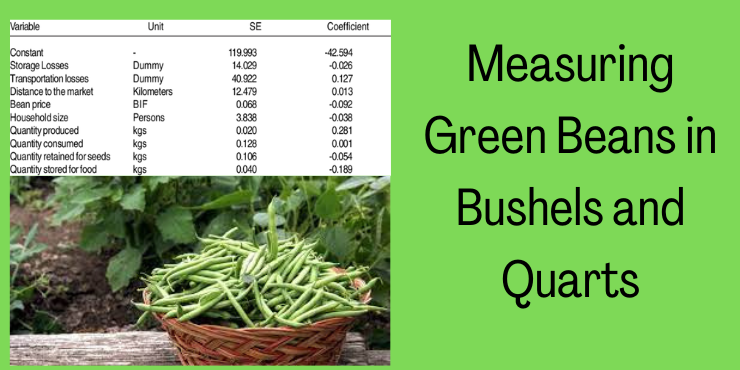Have you ever been to a farmers’ market or walked through a grocery store’s produce section and wondered about the different measurements used for fruits and vegetables? This article aims to shed light on the question of how many quarts are in a bushel of green beans, providing you with both a practical answer and some insights into the world of agricultural measurements. How many quarts are in a bushel of green beans
If you are a farmer then you can follow our topic. And if you love beans
Understanding Bushels and Quarts
Before we delve into the specifics of green beans, let’s clarify what bushels and quarts are. A bushel is a unit of volume used in agriculture to quantify dry commodities like grains, fruits, and vegetables. A quart, on the other hand, is a unit of liquid volume. Both measurements are commonly used to determine the quantity of produce. there are 4 pecks or 32 quarts in a bushel. A bushel is a measure of dry volume that is equal to 32 quarts.
Green Beans: A Popular Crop
Green beans, known for their vibrant color and delicious taste, are a staple in many cuisines around the world. They are not only a versatile ingredient but also a popular choice for home gardeners due to their relatively easy cultivation.
Green beans are very beneficial for the body as they contain iron and vitamins. It is everyone’s favorite food that people plant in their backyards
Measuring Green Beans in Bushels and Quarts

The conversion of green beans from bushels to quarts depends on the specific type of bean and its density. Generally, a bushel of green beans is equivalent to 32 quarts. However, this can vary slightly based on factors like moisture content and bean size. approximately 4 pecks (US) or 8 dry gallons (US).
The Conversion Process
Converting bushels to quarts involves a simple mathematical calculation. Since a bushel is equal to 32 quarts, you can multiply the number of bushels by 32 to get the equivalent in quarts. This conversion is essential for farmers, distributors, and anyone involved in the production and sale of green beans. searches for the first rule that matches the incoming data, and then applies the action associated with that rule
Factors Affecting Green Bean Measurements
Several factors can impact the accuracy of measurements when dealing with green beans. These include variations in size, moisture content, and packing density. It’s crucial to consider these factors when measuring green beans for commercial or personal use. soil and air temperatures above 60ºF and Seedlings will emerge in 7-10 days when planted in soil that has warmed to 65-85ºF. And common bean yields will start to decline once temperatures exceed 18°C to 19°C at night.
Historical Significance of Bushels
The use of bushels as a measurement dates back to medieval times. It was a practical way for farmers to trade and sell their crops. The consistency of this measurement across generations has contributed to its enduring relevance in modern agriculture. unit of capacity in the British Imperial and the United States Customary systems of measurement. and since 1824 a bushel has been defined as 8 imperial gallons, or( 2,219.36) cubic inches (36,375.31) cubic cm.
Modern Applications
In contemporary times, accurate measurements of green beans play a vital role in distribution, pricing, and overall supply chain management. Whether you’re a local farmer or a large-scale distributor, understanding bushels and quarts is crucial for business success.
Culinary Uses of Green Beans
part from the agricultural perspective, green beans are cherished for their culinary versatility. Haricot Vert, snap beans, wax beans and filet beans
they can be steamed, sautéed, stir-fried, or added to soups and stews. Their nutritional value and crisp texture make them a favorite in various dishes.
Maximizing Green Bean Yields
For those interested in growing green beans, maximizing yields is a top priority. Choosing the right variety, providing proper care, and ensuring optimal growing conditions are all essential factors in achieving a bountiful harvest. when temperatures lie between 15 – 28C
if temperatures fall to 4C or go above 35C. Well drained soils are preferred with an ideal pH of 5,5 to 6,5 (CaC12.
Tips for Storing Green Beans

Proper storage is essential to maintain the freshness and flavor of green beans. Storing them in a cool and humid environment, such as the crisper drawer of your refrigerator, can help prolong their shelf life. Store unwashed fresh beans in an reusable container then plastic bag in the refrigerator crisper.
Exploring Other Produce Measurements
While we’ve focused on green beans, it’s worth noting that different crops have unique measurement standards. For instance, the conversion of bushels to pounds varies depending on the product. Exploring these measurements can provide valuable insights into the world of agriculture.
Your are a Keep the soil moist but not soggy; allow the soil surface to dry up to a half-inch deep between watering.
Final thought:
In conclusion, the answer to the question “how many quarts are in a bushel of green beans?” is 32 quarts. This simple yet fascinating conversion plays a significant role in the agricultural and culinary worlds. Whether you’re a farmer, a cook, or just curious about measurements, understanding the relationship between bushels and quarts adds depth to your knowledge.